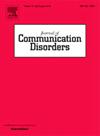Early language outcomes of children born with unilateral aural atresia
IF 2.1
3区 医学
Q2 AUDIOLOGY & SPEECH-LANGUAGE PATHOLOGY
引用次数: 0
Abstract
Objective
Aural atresia is a congenital malformation involving the ear canal. There is limited investigation into the impact of aural atresia and the associated hearing loss on language in the early years of development.
Methods
Eight children with unilateral aural atresia were followed longitudinally at 30- and 60-days post hearing device fitting, 12 months, 18 months, 24 months, 30 months, and 36 months of age. Expressive language, auditory development, functional auditory performance, and hearing device use were measured.
Results
Two children were delayed in expressive language at 24 months of age. Children's auditory development and functional auditory performance were in the average or above average range. Children wore their hearing devices for an average of 1–2 hours per day.
Conclusion
Thirty-three percent of children (n = 2) were performing below the language levels expected for peers without hearing loss. Children's auditory development and functional auditory performance are comparable to children with typical hearing despite their low hearing device use. These results should be interpreted with caution due to the small number of children participating in the study.
单侧失聪儿童的早期语言预后
摘要目的耳闭锁是一种累及耳道的先天性畸形。在发育的早期,关于听觉闭锁和相关听力损失对语言的影响的调查有限。方法对8例单侧耳闭锁患儿分别在配戴助听器后30、60天、12个月、18个月、24个月、30个月、36个月进行纵向随访。测量了表达性语言、听觉发展、功能性听觉表现和助听器使用情况。结果2例患儿在24月龄时出现语言表达迟缓。儿童听觉发育和功能性听觉表现处于中等或中等以上水平。儿童平均每天佩戴助听器1-2小时。结论33%的儿童(n = 2)的语言表现低于无听力损失的同龄人的预期水平。儿童的听觉发育和功能性听觉表现与正常听力儿童相当,尽管他们的听力设备使用较少。由于参与研究的儿童人数较少,因此对这些结果的解释应谨慎。
本文章由计算机程序翻译,如有差异,请以英文原文为准。
求助全文
约1分钟内获得全文
求助全文
来源期刊

Journal of Communication Disorders
AUDIOLOGY & SPEECH-LANGUAGE PATHOLOGY-REHABILITATION
CiteScore
3.30
自引率
5.90%
发文量
71
审稿时长
>12 weeks
期刊介绍:
The Journal of Communication Disorders publishes original articles on topics related to disorders of speech, language and hearing. Authors are encouraged to submit reports of experimental or descriptive investigations (research articles), review articles, tutorials or discussion papers, or letters to the editor ("short communications"). Please note that we do not accept case studies unless they conform to the principles of single-subject experimental design. Special issues are published periodically on timely and clinically relevant topics.
 求助内容:
求助内容: 应助结果提醒方式:
应助结果提醒方式:


